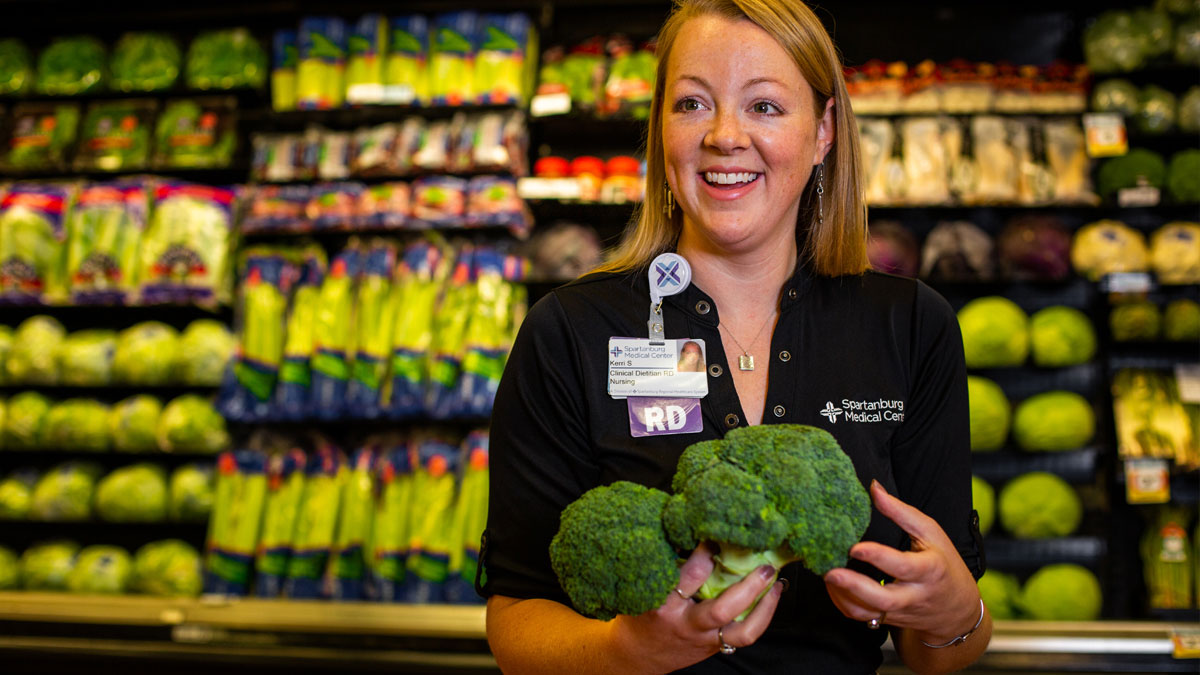Everyone goes shopping for groceries, most of us at least once a week. We cruise through the aisles past an abundance of appealing food items, loading our carts with everything from Almond Joy candy bars to zucchini. But do we ever give more than a passing thought to what we are doing and why?
That’s not the approach favored by Clinical Dietitian magazine, which termed guided grocery store tours “the perfect learning laboratory to provide nutrition education to consumers.” And South Carolina dietitians agree.
Spartanburg Regional Healthcare System’s Kerri Stewart, RD, said that grocery tours offer “a more hands-on way to talk about nutrition in an environment people seem to enjoy.” Having “toured” some 700 people since her first grocery store expedition in 2013, she’s had plenty of experience.
Trident and Summerville Medical Center’s clinical dietitian, Jennifer Mazzaro, RD, LD, concurs that healthy shopping on a budget can help people live well and live longer, and grocery store tours are an excellent way to convey nutritional information in a nontraditional setting.
Both registered dietitians take basically the same approach – small groups, with at least one hour dedicated to combing the food departments, discussing what they find and a question-and-answer period.
They agree that the best place to start is the produce department, which is almost always the first and most prominent sales area. Then, they say, covering the perimeter of the store is best because, as Mazzaro put it, “that’s where you’ll find the foods you want and need the most: produce, meats and dairy products.”
In the produce department, Stewart doesn’t play favorites among the fruits and vegetables. Instead, she stresses that both are good for you, then she goes through the rainbow of colors of red, green, white and brown vegetables, emphasizing what compounds they contain and how they can help with specific health issues such as high blood pressure.
In meats, Stewart and Mazzaro offered similar recommendations. First, they say that less meat overall is best for health. Savvy customers should buy only lean meats – an example would be ground beef with a 90/10 ratio of lean to fat – and avoid fatty chicken parts such as thighs. Stewart carries a small tube that contains the same amount of fat that’s in a portion of lean meat as a visual aid.
Mazzaro tells tourers that meat isn’t the only good source of protein; so are eggs – which takes us to dairy. Both dietitians strongly recommend dairy-free milk alternatives or fat free (skim) milk over whole milk. They point out unit pricing and urge economy-minded shoppers to consider larger amounts, which are generally less expensive and can be frozen if necessary. Yogurt is considered something of a “health food,” but the experts again recommend checking the nutritional labels because many brands have a considerable amount of added sugar.
Last, but far from least, their grocery store tours include roaming the interior aisles, explaining that canned or frozen vegetables can be nutritional and fresh and cautioning their health-conscious shoppers to be wary not only of the candy aisle but also of the appealing displays of chips and other snack foods.
“It makes a difference in the learning process for people to hear the facts about nutrition in a real-life situation,” Stewart said. “We look at actual food in the store and afterward our shoppers can look at the handouts I give them to refresh their memories.”
She noted that most of her grocery store tour shoppers are over 50 years of age, often lower income and even include the disabled, who get special tours geared to their needs.
She’d like to tour with younger people as well and is beginning to extend her reach through college nutrition courses.
Mazzaro concluded, “When I do a grocery shopping tour, I never tell shoppers that any foods are ‘banned.’ I just tell them to learn the facts about nutrition, shop smart, take a look at what’s on the shelves, then decide what’s really good for you. Grocery store touring is really a lot of fun!”
By Bill Farley
